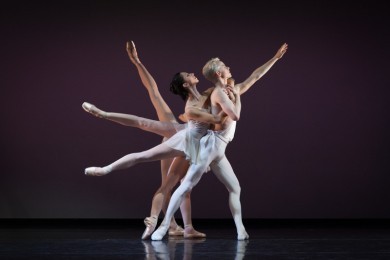APOLLO
ballet in two scenes
CREDITS
Music by Igor Stravinsky
Choreography by George Balanchine (1928)
Libretto by Igor Stravinsky
Staging by Francia Russell
Original lighting design by Ronald Bates
Lighting: Vladimir Lukasevich
World premiere: 12 June 1928, Les Ballets Russes de Serge de Diaghilev, Théâtre Sarah Bernhart, Paris
Premiere at the Mariinsky Theatre: 26 January 1992
Premiere of last revived version at the Mariinsky Theatre: 30 April 1998
Running time 35 minutes
The Ballet of George Balanchine Apollo is presented by arrangement with The George Balanchine Trust and has been produced in accordance with the Balanchine Style® and Balanchine Technique® service standards established and provided by the Trust.
The Mariinsky Theatre would like to express its gratitude to Mrs Bettina von Siemens for her support in bringing the "Ballets of George Balanchine" project to life.
Apollo, the son of Zeus and Leto, achieves stunning levels of brilliance in dance and citherplaying. He is followed in his sequence of dance by his ever-present companions the three muses – Calliope (the muse of epic poetry), Polyhymnia (the muse of sacred hymns) and Terpsichore (the muse of dance). When Apollo, accompanied by his muses, appears on Mount Olympus everything around him falls silent in adoration of his divine art.
“I regard Apollo as a turning point in my life. In terms of discipline, restraint, the perpetual unison of sound and mood this score was a revelation for me. It seemed to be telling me that I didn’t have to use it all, that I could leave something out. In Apollo and all of the composer’s subsequent music it is impossible to imagine any one given extract to be an extract from another score. Each of them is unique, nothing can be replaced. I examined my own work in the light of that lesson. It was when studying Apollo that I first understood that the gestures, like tones in music and shades in painting, find certain ‘native ties’ between themselves. Like any group they are subject to their own special laws. And the more solid the artist the more clearly he will understand and consider these laws. Starting with Apollo I developed my choreography along these lines, dictated by these mutual ties. “Apollo has sometimes been criticised for its ‘lack of theatricality.’ It may be true that there is no vividly expressed story there (although there is a plotline that runs throughout). But its technique is that of classical ballet which in every sense is theatrical, and it is here that we see the start of the literal transformation of sound into visual movement.”
George Balanchine. The Dance Element in Stravinsky’s Music
Age category: 12+
SCHEHERAZADE
choreographic drama in one act
CREDITS
Music by Nikolai Rimsky-Korsakov
Scenario by Léon Bakst and Michel Fokine after Arabian Nights fairytales
Choreography by Michel Fokine (1910)
Reconstruction by Isabelle Fokine, Andris Liepa
Set and costume design by Anna Nezhnaya, Anatoly Nezhny after original sketches: Léon Bakst
SYNOPSIS
Shahryar is angry because his brother Shakhezman has suggested that his wives are unfaithful to him. To test the harem Shahryar goes off on a hunting expedition.
Almost as soon as the court has departed the wives adorn themselves in jewels and bribe the Chief Eunuch to open the three doors which lead to the quarters where the male slaves live. Two doors are opened and the Chief Eunuch is about to leave when Zobeide, Shahryar’s favourite wife, demands that the third door also be opened. The Eunuch warns her against this, but with further bribes and pleas she insists. The door is opened and the Golden Slave leaps through it to Zobeide’s side. They fall entwined upon the divan. Food is brought in to musical accompaniment. Dancing begins, led by the Golden Slave, and Zobeide joins it. But Shahryar has returned unannounced and bursts in upon the orgy. Slaughter follows and the revellers are indiscriminately cut down. Shahryar kills Zobeide’s lover with his own hands. Only Zobeide remains. Preferring death to dishonour she faces the Shah and then, with a dagger she grabs from him, she takes her own life.
ABOUT THE PRODUCTION
In 1910, Shéhérazade was a great success in Paris. The fashionistas of the time, having just shouted "bravo" at Les saisons russes premiere, hurried to put on serouals and turbans à la Eastern style which were created for the production by artist Léon Bakst. Fabric manufacturers launched the production of linens with ornaments in blue and orange colours, while jewelers sold gaudy trinkets, which were reminiscent of the shiny things worn by the artists on stage, with unprecedented success. Sergei Diaghilev was hoping to make a splash with a Paris performance of the ballet written after One Thousand and One Nights with the fabulous music by Rimsky-Korsakov and oriental exotics. Fokine sought to show all actions and feelings through poses and movements in his choreography. Ida Rubinstein drove the public crazy with her regal beauty, Vaslav Nijinsky – with animal-like flexibility of his half-naked body while soaring over the stage. Such passionate orgies as in Shéhérazade had never been seen by the Parisian ballet-goers before. And while modern theatre-goers would unlikely be stunned by the scenes of passionate embraces and bloody massacre at the harem, juicy musical, artistic and choreographic elements of Shéhérazade can still fire the imagination of a sensitive spectator.
World premiere: 4 June 1910, Les Ballets Russes de Serge de Diaghilev, Théâtre de l´Opéra, Paris
Premiere at the Mariinsky Theatre: 26 May 1994
Running time 45 minutes
Age category: 6+
 Mariinsky Theatre:
Mariinsky Theatre:  Mariinsky-2 (New Theatre):
Mariinsky-2 (New Theatre):  Mariinsky Concert Hall:
Mariinsky Concert Hall: 

